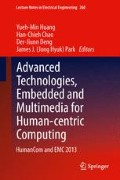Abstract
Nearest classification with prototype generation methods would be successful on classification in data mining. In this paper, we modify the encoded form of the individual to combine with the proportion for each class label as the extra attributes in each individual solution, besides the use of the PSO algorithm with the Pittsburgh’s encoding method that include the attributes of all of the prototypes and get the perfect accuracy, and then to raise up the rate of prediction accuracy.
Access this chapter
Tax calculation will be finalised at checkout
Purchases are for personal use only
References
Cover T, Hart P (1967) Nearest neighbor pattern classification. IEEE Trans Inf Theory 13(1):21–27
Gowda K, Krishna G (1979) The condensed nearest neighbor rule using the concept of mutual nearest neighborhood (corresp.). IEEE Trans Inf Theory 25(4):488–490
Wilson DL (1972) Asymptotic properties of nearest neighbor rules using edited data. IEEE Trans Syst, Man and Cybern 3:408–421
Brighton H, Mellish C (2002) Advances in instance selection for instance-based learning algorithms. Data Min Knowl Disc 6(2):153–172
Marchiori E (2008) Hit miss networks with applications to instance selection. J Mach Learn Res 9:997–1017
Fayed HA, Atiya A (2009) A novel template reduction approach for the k-nearest neighbor method. IEEE Trans Neural Networks 20(5):890
Marchiori E (2010) Class conditional nearest neighbor for large margin instance selec- tion. IEEE Trans Pattern Anal Mach Intell 32(2):364–370
Wilson DR, Martinez TR (2000) Reduction techniques for instance-based learning algorithms. Mach Learn 38(3):257–286
Fayed HA, Hashem SR, Atiya AF (2007) Self-generating prototypes for pattern classification. Pattern Recogn 40(5):1498–1509
Lam W, Keung C-K, Liu D (2002) Discovering useful concept prototypes for classification based on filtering and abstraction. IEEE Trans Pattern Anal Mach Intell 24(8):1075–1090
Bezdek JC, Kuncheva LI (2001) Nearest prototype classi_er designs: an exper-imental study. Int J Intell Syst 16(12):1445–1473
Cervantes A, Galván IM, Isasi P (2009) Ampso: a new particle swarm method for nearest neighborhood classification. IEEE Trans Syst, Man, Cybern, Part B: Cybern 39(5):1082–1091
Triguero I, Garcia S, Herrera F (2011) Differential evolution for optimizing the positioning of prototypes in nearest neighbor classification. Pattern Recog 44(4):901–916
Nanni L, Lumini A (2009) Particle swarm optimization for prototype reduction. Neurocomputing 72(4):1092–1097
Triguero I, Garcia S, Herrera F (2010) A preliminary study on the use of differfiential evolution for adjusting the position of examples in nearest neighbor classification. In 2010 IEEE congress on evolutionary computation (CEC). IEEE, pp 1–8
Author information
Authors and Affiliations
Corresponding author
Editor information
Editors and Affiliations
Rights and permissions
Copyright information
© 2014 Springer Science+Business Media Dordrecht
About this paper
Cite this paper
Chen, JL., Tseng, SP., Yang, CS. (2014). Using Particle Swarm Method to Optimize the Proportion of Class Label for Prototype Generation in Nearest Neighbor Classification. In: Huang, YM., Chao, HC., Deng, DJ., Park, J. (eds) Advanced Technologies, Embedded and Multimedia for Human-centric Computing. Lecture Notes in Electrical Engineering, vol 260. Springer, Dordrecht. https://doi.org/10.1007/978-94-007-7262-5_28
Download citation
DOI: https://doi.org/10.1007/978-94-007-7262-5_28
Published:
Publisher Name: Springer, Dordrecht
Print ISBN: 978-94-007-7261-8
Online ISBN: 978-94-007-7262-5
eBook Packages: EngineeringEngineering (R0)

